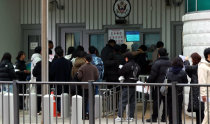36,000 international students quit school a year in South Korea
36,000 international students quit school a year in South Korea
Posted August. 17, 2023 08:02,
Updated August. 17, 2023 08:02
The South Korean government announced “Study Korea 300K” to increase the number of overseas students studying in the country up to 300,000 by 2027. Under the government-led plan, universities, local municipalities, and businesses will create a task force to set up a wide range of strategies based on economic needs in their communities from student recruitment to career consultation while inviting overseas talents to cutting-edge and emerging industries including semiconductors and batteries for the sake of a competitive edge.
Since the Study Korea project was launched in 2005, the number of overseas students attending local universities and graduate schools has steadily risen on a yearly basis to reach a record high of 160,000 last year. However, the country only takes up two percent in the global overseas study market. In fact, the share of international students studying in South Korea is 3.7 percent – merely half the average of 6.6 percent among the OECD member states. There are even an increasing number of dropouts. As of last year, 36,000 international students quit school, ending up being illegal aliens. What’s worse, the number of dropouts from academic degree programs saw a sextuple increase last year compared to 2018. Such dismal numbers are not irrelevant to the realities of how related programs are managed and monitored. In particular, financially-strapped universities in the non-capital area are hell-bent on attracting as many international students as possible but pay little attention to managing their programs, leaving them dissatisfied with their school life in South Korea.
The policy package released by the government on Wednesday also gives priority to student recruitment plans by easing evaluation standards of Korean language skills and financial capabilities. Even now, many overseas students find it difficult to keep up with classes because of their low level of the Korean language. As such, educational authorities should identify why overseas students end up quitting school in the country and upgrade systems to help them academically and life-wise. To be specific, local communities lacking educational infrastructure systems can consider working with one another to run support programs.
Only 19 percent of international students graduating from South Korean schools choose to stay longer to go to graduate school or get a job, instead of going back to their home countries right away. This highlights the fact that the government and businesses alike have not considered discovering and utilizing international talents studying locally but are headed abroad to find competent workers. In this light, it is worth noting that as high as 56 percent of international students with a master’s or doctoral degree aspire to join advanced academic programs or work in the country. With it in mind, the government and educational authorities need to redesign visa policies to match the right students with industrial needs on a community level; and lessen regulation in a way that better capitalizes on corporate internship programs targeting international students. Only in an environment where students from overseas can set up and realize their careers based on what they are taught by local universities, will there be consequently an increase in the number of international students dreaming of studying in South Korea.



![라면 5만 개 끓여 보며 성능 테스트… “무인점 라면 조리기 95% 차지”[유레카 모멘트]](https://dimg.donga.com/c/138/175/90/1/wps/NEWS/IMAGE/2025/12/27/133042718.4.jpg)

![스페인·남아공 떴는데, 사우디·태국은 왜…2025년 경제 결산[딥다이브]](https://dimg.donga.com/c/138/175/90/1/wps/NEWS/IMAGE/2025/12/26/133039499.1.jpg)

